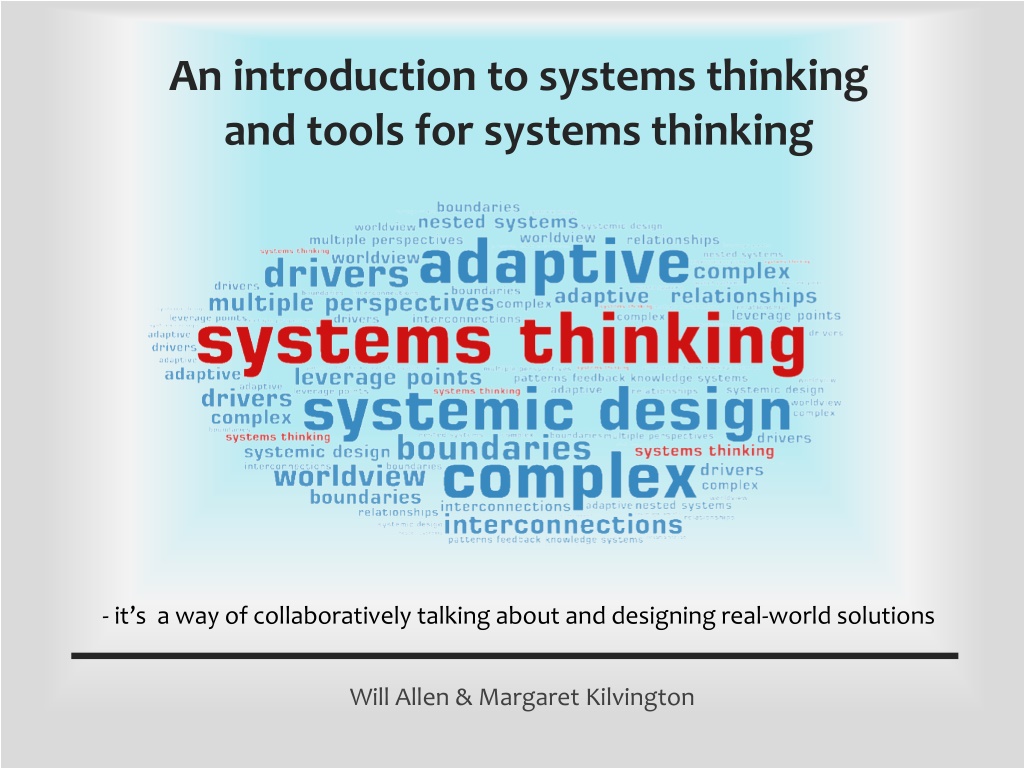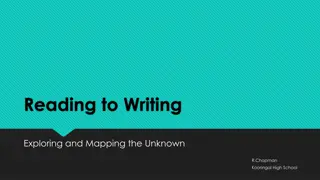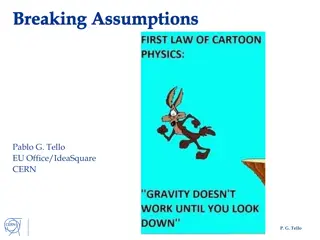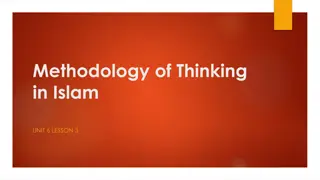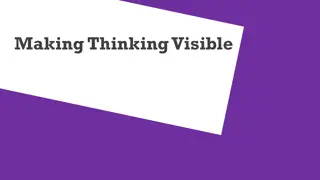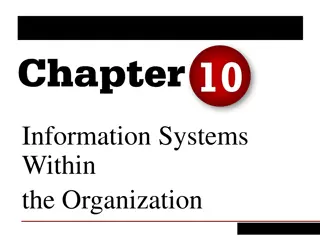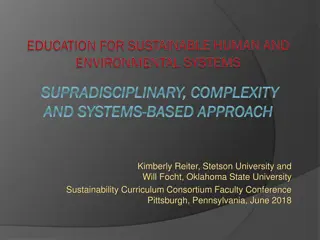An Introduction to Systems Thinking and Tools for Real-world Solutions
Systems thinking is a collaborative approach to problem-solving that helps us understand the interconnected complexity of various fields like health, environment, and education. This method focuses on designing holistic solutions by examining relationships and interdependencies within systems. Through nurturing systems thinking practices, organizations can enhance creativity, innovation, and collective action to address contemporary challenges effectively.
Download Presentation

Please find below an Image/Link to download the presentation.
The content on the website is provided AS IS for your information and personal use only. It may not be sold, licensed, or shared on other websites without obtaining consent from the author. Download presentation by click this link. If you encounter any issues during the download, it is possible that the publisher has removed the file from their server.
E N D
Presentation Transcript
An introduction to systems thinking and tools for systems thinking - it s a way of collaboratively talking about and designing real-world solutions Will Allen & Margaret Kilvington
Content guide 1. Introduction: Why decision-makers are moving towards a systems thinking approach to better deal with complex situations in health, environment, education, etc. 2. Basics of systems thinking 3. Systemic design linking systems thinking and design 4. Introduction to range of tools/methods that support systems thinking and systemic design in practice 5. Nurturing & supporting systems thinking in your practice Reference as: Allen & Kilvington (2018) An introduction to systems thinking and tools for systems thinking (Presentation). Available online https://learningforsustainability.net/wp- content/uploads/2019/01/Intro-systems-thinking-and-systemic-design-concepts-and-tools.pdf 2
1. Why the growing interest in a systems thinking approach 3
We are all systems thinkers We all grew up exploring our natural and social worlds and asking questions born of curiosity. We can look at problems, see beyond the obvious, and explore otherwise hard to see connections. But in many school and workplace settings today knowing the right answers is often rewarded over systems-based inquiry and creativity. Yet in today s more crowded, and rapidly changing, world there are fewer instances where all that is needed is a right answer rather there are more perspectives, interconnections and interdependencies to consider! Hence the growing interest in learning to strengthen systems thinking practices, and manage organisational cultures that encourage its use in both problem structuring and solution design. 4
Systems thinking enables us to: Change our thinking to match the interconnected, dynamic complexity of our communities and their environments Communicate with others to create new ways of thinking and seeing - and develop shared understanding Change our behaviour to work with the complex forces in the system (instead of against them) to realize our vision Identify and test a wider variety of possible actions and solution pathways Become more aware of the potential for unintended consequences of our actions Harness social learning processes to help us develop a shared understanding and take action collectively Expand the choices available to us and identify those choices where we can develop significant leverage 5
Of course - not all systems are the same! There are different kinds of systems Simple / complicated Complex and adaptive We need to understand them, and use different management styles for each Image: Land Information New Zealand 6
A typology of problem situations Complex wicked problems Agreement Complicated difficult problems Simple problems Close to Far from Certainty Modified from work by Ralph D. Stacey and Dave Snowden 7
Limited timescale Priorities clear Recognisable solution Difficult problems Limited applications Know what needs to be done Limited number of people involved Can be treated as a stand-alone matter Difficult problems are characteristically smaller- scale and well-defined 8
Longer, uncertain timescale Priorities called into question No obvious solutions Uncertain, but greater implications, worrying Wicked problems No agreement on what the problem is Can t be disentangled from its context More people involved Keep evolving Wicked (or complex) problems are characteristically bigger and poorly-defined 9
International agencies and public sector organisations are moving towards systems thinking .. 10
International agencies and public sector organisations are moving towards systems thinking .. to deal with complex or wicked problems which go beyond range of any one organization to manage them are often characterised by disagreement about causes, and how to tackle them recognise the need to change behaviour or practice at multiple levels and scales (individuals to organizations) require innovative solutions that can be adapted in the light of experience and feedback 11
Different systems require different management Managing a complicated system Managing a complex adaptive system Look for divergence Act, learn, and plan at the same time Use minimum specifications Work on multiple leverage points Be creative with opportunities at the boundaries Build on what emerges and grows Develop explicit plans Plan then act Look for agreement & clear outcome Limit types of approaches & actions Set targets Drive implementation Complicated or complex knowing the difference is important From: 12
World views Interconnections Multiple Perspectives Voice s Relationships Patterns Knowledge systems Feedback Key systems thinking components Communities Boundaries Blocks Scope Influences Leverage points Drivers 14
Multiple Perspectives Who or what are the key stakeholders in this situation? What stakes (individual values and motivations) do they have? What are the different ways in which the situation can be framed or understood by whom? How do these different framings affect the way in which stakeholders act when things go their way/when things don t go their way? 15
Interconnections How do the elements within the situation (components, stakeholders, knowledge, etc.) interconnect? What is the nature of the relationships between them (e.g. strong/weak, fast/slow, collaborative, direct, indirect, etc.)? What patterns emerge from these relationships in action - with what consequences, and for whom? 16
Boundaries Define scope and scale (and from what/whose perspective is this developed.) Are other boundaries possible and feasible? Agree on how to structure the problem situation Discuss what constitutes an improvement and how this might be different for different stakeholders? 17
Influences What drives the systems in question in particular directions Identify . drivers, trends, enablers, blocks, leverage points Leverage points are seen as key points with which to intervene in complex systems 18
The iceberg model for systems thinking Increasing leverage VISIBLE Events Patterns & trends System structures & drivers Transformational change RARELY SEEN Predominant social paradigm (Mental models, worldviews) The iceberg model is a systems thinking tool designed to help an individual or group discover the patterns of behaviour, supporting structures, and mental models that underlie a particular event. From: Systems thinking: what, why when, where and how ~ by Michael Goodman 1997 19
Some questions to help unpack the system What is the fastest way to react to this event NOW? PRESENT Events What trends and/or patterns are occuring? Patterns & trends What mental/organizational structures create the patterns? System structures & drivers What are the stated/unstated visions that generate this structure? Predominant social paradigm (Mental models, worldviews) FUTURE 20
Donella Meadows 12 leverage points: places to intervene in a system Numbers Buffers Stock and flow structures Delays Balancing feedback loops Reinforcing feedback loops Information flows Rules Self-organization Goals Paradigms Transcending Paradigms Increasing leverage 21 From: Leverage points places to intervene in a system by Donella Meadows
3. Systemic design linking systems thinking and design 22
Linking systems thinking and design Systems thinking + Problem framing Solution oriented Design thinking Systemic design - integrating the mindsets and toolsets of systems thinking and design thinking to encourage learning and innovative systems change Systemic design For more information: 23
Systemic design These frameworks link together to support collaborative decision-making. For example key functions in a typical adaptive management/policy setting process may include: [Systems thinking] Involving participants in understanding issue and wider context (recognizing different perspectives/problem structuring, potential leverage points) [Design thinking] Jointly develop action plans (identify activities, outcomes, and assumptions) and M&E plans [Reflective thinking] Learn and refine (adaptive management) 24 Systemic design For more information:
Tools/methods for systems thinking and systemic design can be grouped by function Understanding the system Co-designing solutions Monitor, reflect and adapt Dialogue and collaboration The first three functions essentially can be seen as linked elements in an iterative and experiential learning cycle in a systems approach each is best carried out using tools that support dialogue and collaboration among the stakeholder groups involved. 25
Tools/methods for systemic design - supporting an experiential learning cycle Understanding the system Boundaries + Influences Interrelationship Leverage points Action plans Co-design solutions Dialogue & collaboration Short term and long term goals Choose indicators Assess and adapt Refine Multiple perspectives Managing conflict monitor Assess progress Recognising different knowledge systems and cultures Implementation by organizations, other key stakeholders 26
4. Tools and methods for systems thinking and systems design There are so many! 27
All tools are wrong. Some tools are useful. Over the years, I ve found that starting with methods, whether causal loop diagrams or Soft Systems Methodology or Social Network Analysis, often confuses or exasperates novices . furthermore, no single method will equip them with the power of the systems field. ~ Bob Williams https://thesystemsthinker.com/%EF%BB%BFall-methods-are-wrong-some-methods-are-useful/ 28
Important to see how sets of tools/methods fit in the bigger process in which they are used Understanding the system Boundaries + Influences Interrelationship Leverage points Action plans Co-design solutions Dialogue & collaboration Short term and long term goals Choose indicators Assess and adapt Refine Multiple perspectives Managing conflict monitor Assess progress Recognising different knowledge systems and cultures Implementation by organizations, other key stakeholders 29
1. Tools for understanding the system Understanding the system + Boundaries Influences Interrelationship Leverage points Action plans Co-design solutions Dialogue & collaboration Short term and long term goals Choose indicators Assess and adapt Refine Multiple perspectives Managing conflict monitor Assess progress Recognising different knowledge systems and cultures Implementation by organizations, other key stakeholders 30
1. Understanding the system - tools for seeing things Timelines Trend analysis System archetypes Rich pictures Cynefin framework/Stacey diagram Concept mapping Social network analysis Causal loop diagrams Bayesian belief networks Computer models etc Systems methods and tools 31 For more information:
Understanding the system - tools for thinking strategically CATWOE Iceberg model System archetypes Soft Systems Methodology (SSM) Scenarios and visioning Problem structuring methods SWOT/TOWS analysis STEEP (PEST, PESTLE, STEP, etc.) etc Strategy tools and approaches For more information: 32
2. Tools for dialogue and collaboration 2 Understanding the system Boundaries + Influences Interrelationship Leverage points Action plans Co-design solutions Dialogue & collaboration Short term and long term goals Choose indicators Assess and adapt Refine Multiple perspectives Managing conflict monitor Assess progress Recognising different knowledge systems and cultures Implementation by organizations, other key stakeholders 33
Dialogue & collaboration tools for involving the right people include: Stakeholder analysis Engagement planning Networking Relationship building & management Not just who you could get to come at the time Source: http://weird-vintage.com 34 Stakeholder mapping and analysis For more information:
Dialogue & collaboration tools for working together Use multiple methods and always have a plan. Tools include: Facilitation Kitchen workshops and meetings Informal conversations Networks Social media Active listening, appreciative inquiry ... Don t travel the same road every time Source: www.pexels.com 35 Using dialogue and negotiation For more information:
3. Tools for co-designing solutions Understanding the system Boundaries + Influences Interrelationship Leverage points Action plans Co-design solutions Dialogue & collaboration Short term and long term goals Choose indicators Assess and adapt Refine Multiple perspectives Managing conflict monitor Assess progress Recognising different knowledge systems and cultures 3 Implementation by organizations, other key stakeholders 36
Tools for co-design finding desirable solutions Usually both a product and a process. Approaches include: Agile planning (scrums & sprints) . as opposed to waterfalls The five stages of Design Thinking (Empathise, Define the problem, Ideate, Prototype, and Test) Along with a whole host of methods . problem structuring methods (PSMs), conceptual models, scenario development, (participatory) system dynamic modelling and simulation, etc. 37
Tools for co-design outcomes modelling [Theory of Change (ToC) and logic models] Situation analysis Outcomes Inputs, activities & outputs Vision For more information: Theory of Change and logic models 38
can account for acknowledgement that people and organisations need to change first Situation analysis Outcomes Inputs, activities & outputs Outcomes - Impact Intermediate Long-term Changes - in individuals & organisations Vision Changes in practice Changes in end states 39
and helps develop monitoring and evaluation plans along with activity plans For more information: Planning, monitoring & evaluation closing the loop 40
4. Tools/methods for assessing progress Understanding the system Boundaries + Influences Interrelationship Leverage points Action plans Co-design solutions Dialogue & collaboration Short term and long term goals Choose indicators Assess and adapt Refine Multiple perspectives Managing conflict monitor Assess progress Recognising different knowledge systems and cultures 4 Implementation by organizations, other key stakeholders 41
Tools for assessing and adapting include: Theory of change and accompanying logic models Complexity-aware monitoring (outcomes mapping, MSC, etc.) Using rubrics to assess complex tasks and behaviours (intermediate outcomes) Facilitating reflective practice (After Action Reviews AARs and Strategic Learning Debriefs 42 For more information: Planning, monitoring & evaluation closing the loop
5. Embedding systems thinking in practice 43
It is important to create a learning organisation where: people continually expand their capacity to create the results they truly desire new and expansive patterns of thinking are nurtured collective aspiration is set free and people are continually learning to see the whole together. ~ Peter Senge 1990 The Fifth Discipline 44
Common challenges that often have to be faced include The perception that learning (collaboration and dialog) takes too long Too few people with the skillsets and resources required to follow through Exploring one s personality and goals in a group can sometimes seem threatening and daunting A lack of safe spaces for groups to work in this different way A lack of formal commitment to the process from organisational leadership 45
Senge: the five core disciplines required for a successful learning organization Systems Thinking Personal Mastery Mental Models Building Shared Vision Team Learning 46 Image source: Peter Senge Systems Thinking
A screenshot of a cell phone Description generated with very high confidence 47 47 For more information visit: http://learningforsustainability.net
For more information Dr Margaret Kilvington margaret.kilvington@gmail.com - Independent Social Research, Evaluation & Facilitation Dr Will Allen willallennz@gmail.com - Will Allen & Associates / Learning for Sustainability Annotated links to a wide range of related on-line material can be found via the Learning for Sustainability clearinghouse - https://learningforsustainability.net/ Reference as: Allen & Kilvington (2018) Summary: An introduction to systems thinking and tools for systems thinking (Presentation). Based on material for a Greater Wellington Regional Council introductory systems thinking workshop, Wellington, New Zealand. Available online https://learningforsustainability.net/wp- content/uploads/2019/01/Intro-systems-thinking-and-systemic-design-concepts-and-tools.pdf 48
